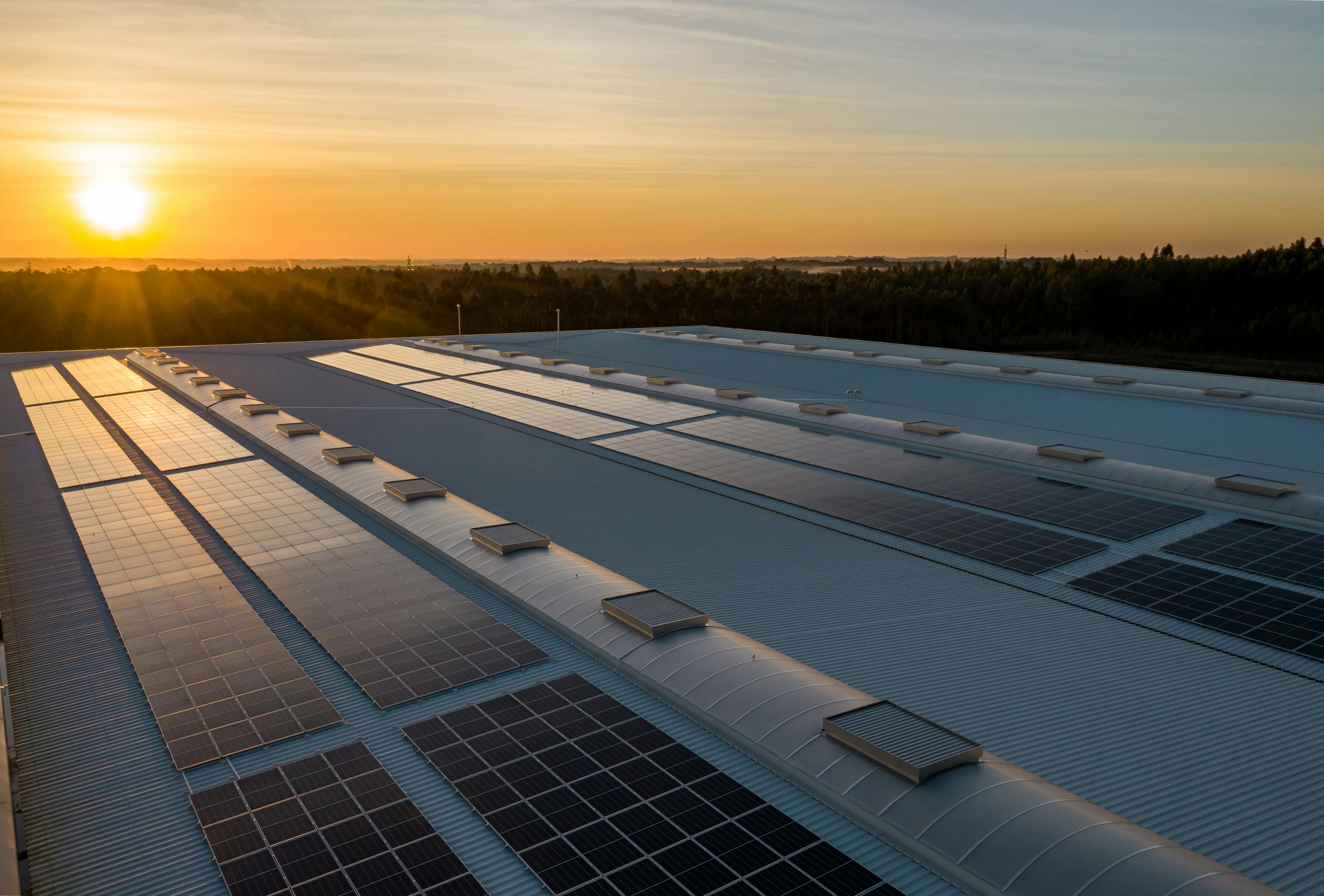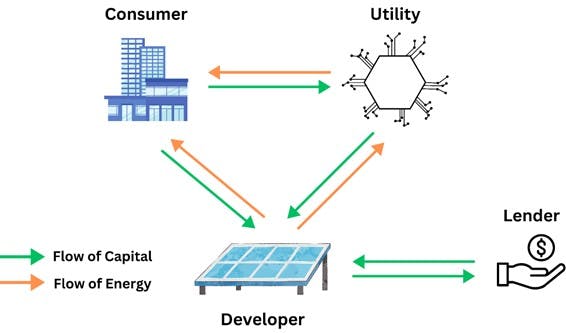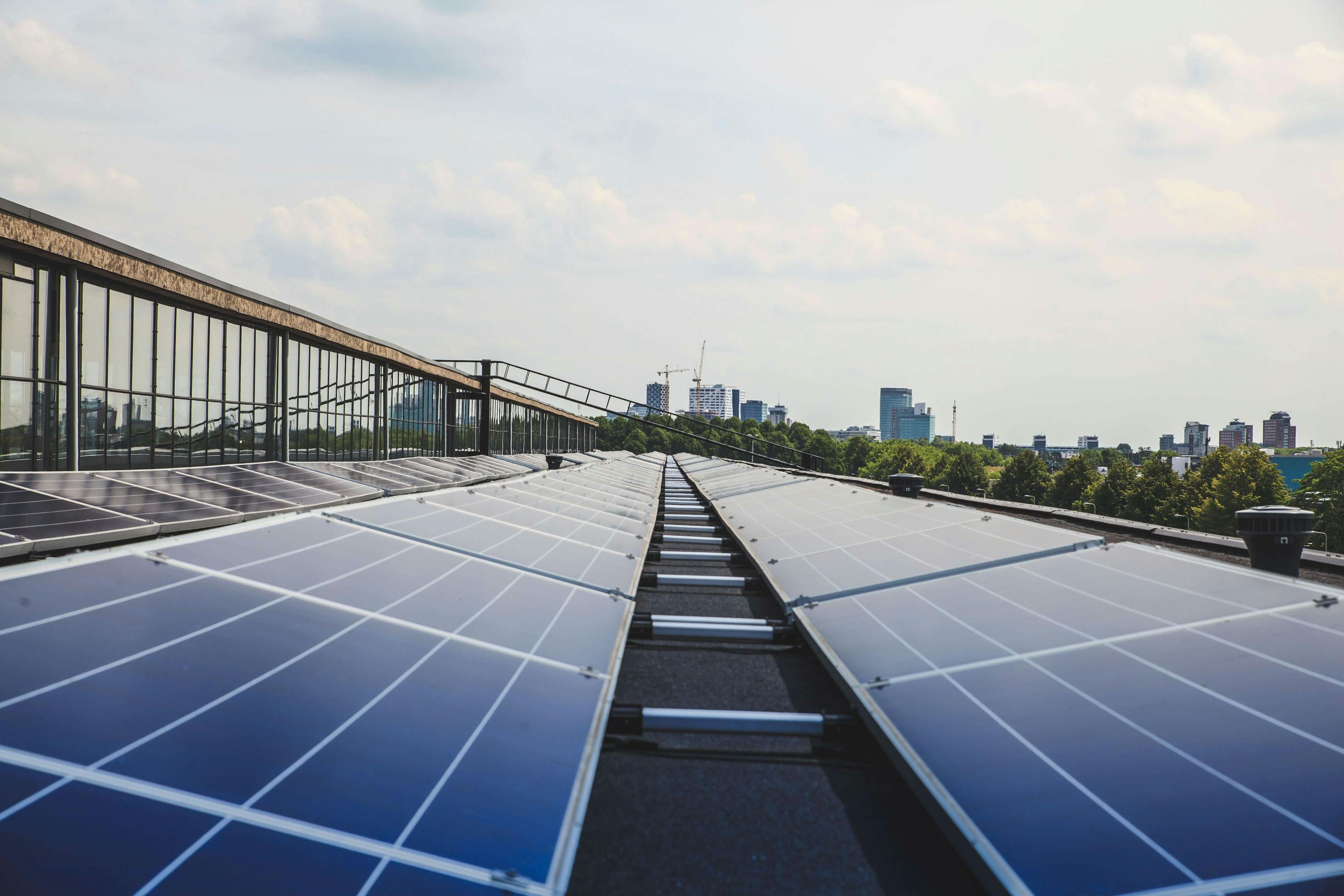Solar PPAs Explained: Harnessing Renewable Energy through Power Purchase Agreements
5 Dec 2023

This article on Solar PPAs supports our guides to Power Purchase Agreements (PPAs). Solar PPAs are contractual obligations used to fund retail and utility-scale solar energy projects. Adopting methods to fund renewable energy projects is integral to keeping these projects functioning.
There are several fundamentals to understanding how Solar PPAs work. The pros and cons of solar PPAs need to be assessed and include considerations. If you’re seeking capital to cover the upfront costs of your solar system, Solar PPAs may be the option for you.
What is a Solar PPA?
Power Purchase Agreements (PPAs) are long-term contracts for the sale of electricity generated by renewable energy projects. These contracts are between the buyers and sellers of electricity and will guarantee consistent income for developers. PPAs confirm projects as revenue-generating assets and help to secure stable financing, reduce project risk, and repay loans over time.
PPAs are generally broken down into two categories, physical and virtual, and provide project developers with proof of revenue stability – a critical function when unlocking investment – and energy buyers with various incentives that include cost savings, routes to conforming with sustainability and emission targets etc. Solar PPAs occur when individuals, businesses, or organisations (buyers) want access to cheap, reliable and clean solar electricity without the ability to pay upfront costs. For this electricity, buyers offer property rights to developers to build solar projects, often on newly available space (e.g., a warehouse roof).
On-site and off-site PPAs are examples of physical PPAs. On-site PPAs involve solar projects installed on the customer's premises and involve a great deal of planning and evaluation on the property. These PPAs have higher upfront costs to build the system but lower long-term costs. On the other hand, they offer a greater risk to the off-taker as the system is now attached to their property. Alternatively, Off-site PPAs exist when solar projects are installed at a separate location from the buyer’s premises. This may be because the customer does not have the capacity for the system or there is a reliable grid connection to transfer electricity from the project back to the consumer.
How does a Solar PPA work?
Solar PPAs offer a financial strategy for large-scale developers of solar energy projects. The different parties involved include developers, lenders, and buyers of the energy.
The energy and capital flow begins with a consumer who wants cheaper, cleaner, less volatile energy through a switch to solar without long-term uncertainty by locking in price predictability. Importantly, these consumers have access and the ability to offer space for said solar project. An example would be a warehouse owner or an industrial company. Selling property access to a developer means they can generate the electricity to be returned to the consumer either directly or indirectly. Importantly, the landowner does not pay upfront project costs for site evaluation, installation etc. These are shifted to the developer. Depending on the size of the developer, they can either absorb these costs or secure funding from a lender to design, install, and manage solar power systems for consumers. Once operational, electricity generated by the project is sold back to the consumer through a solar PPA. In times of low demand, excess electricity can be sold back to utilities instead of the consumer to give additional revenue. During periods of high energy demand, consumers may have to supplement their needs at a higher price from a utility. Utilities will benefit from the project’s excess electricity by selling at a profit either directly back to the consumer or a separate consumer via the grid.
Developers are incentivised in several short, medium and long-term aspects. Firstly, being the project owners entitles developers to immediate and significant tax breaks. Also, the PPA structure means that excess electricity can be sold back to the grid at a higher price to create revenue during times of high supply. After the loan repayment period, developers will profit from the electricity sale over the remaining duration of the PPA. Nevertheless, the biggest benefit in some cases to developers is project ownership. Operational projects with a PPA and off-taker in place have a high value. Whether or not developers can sell the project is dependent on the land agreement with the consumer.

Key elements and components of a solar PPA
System design and installation
Once a consumer has expressed interest in a solar PPA, developers will assess the energy requirements. Consumer demand over time as well as daily and yearly fluctuations must be taken into account. This will target synchronicity between potential supply and demand to balance a PPA. Next, developers and engineers must decide if the consumer has the capacity to have solar panels installed on-site. One important consideration is the infrastructure to transport the electricity from the developer to the consumer. This connectivity cost is why it is easier to facilitate onsite PPAs compared to offsite. If the utility facilitates a reliable grid connection, the system may be installed in a location that has more capacity to maximise energy production due to more sunlight or more space.
Ownership and operation responsibilities
As the owner and operator of the project, the developer is responsible for covering its maintenance and performance costs, typically through debt, throughout the agreement. This relieves the customers of maintenance and operational tasks that are time-consuming and labour-intensive. At the end of the contract, the customer may have the option to buy out this system. In this case, ownership will transfer to the customer and they will be responsible for all of the costs and risks.
Electricity purchase terms
The electricity purchase terms provide the main incentive for customers to sign a PPA. They often determine a rate, lower than retail electricity, at which the customer agrees to purchase the electricity generated by the project. The purchase terms also outline termination clauses and duration. This will be discussed in greater detail throughout this blog.
Contract duration and financial considerations
Solar PPA contracts typically last 10-25 years to align with the project lifespan caused by inefficiencies that develop over time. This allows developers to secure long-term financing for the initial project costs. Problems arise if the consumer’s land does not overlap with the PPA duration. For example, if a warehouse is leased for a shorter time than the PPA, there should be provisions for extension and buyout embedded in the contract. Another financial consideration is the asset value. Valuation is specific to project duration and can be increased through solar repowering. Once installed, the PPA and project can become part of the property. This will increase the asset valuation for those looking to sell. However, the tax on the asset may increase and the solar PPA could be a barrier to buyers who want the flexibility.
Creditworthiness is important because upfront costs are often debt-financed. This means that the consumer, developer, and lender must commit to the PPA terms to ensure cash flow available for debt service. If the off-taker cannot make their PPA payments and electricity cannot be sold at a sufficient price, the developer could default on its debts.
What are the Benefits of Solar PPAs?
Financial benefits for consumers
Avoidance of upfront capital costs
Solar PPAs give access to clean energy without requiring investments in solar infrastructure. The off-taker only commits to purchasing the electricity used over the PPA's term. This means they can allocate their capital to other core business activities.
No maintenance or insurance costs
Customers of PPAs are free from insurance, operation, and maintenance costs. For example, rooftop repairs and trimming trees that shade the panels are the responsibility of the developer. This not only saves time and money for the consumers but also mitigates most financial risks associated with a PV system.
Long-term electricity price stability
Traditional energy markets are highly volatile. PPA contracts provide price stability, protecting customers from market fluctuations if using spot market sales. This allows them to budget for future energy costs. Take the energy crisis from the war in Ukraine for example. It was estimated that the crisis cost UK energy suppliers an additional £50bn to 60bn. Customers of PPAs were unaffected by this spike in energy prices as they had already locked in a stable electricity rate.
Potential savings on energy bills
Solar PPAs provide cost savings for customers compared to traditional grid electricity. The price of the solar PPA is typically less than the price of regular utilities. These variable cost reductions allow customers to be leaner in their operational expenses. Solar PPAs are as much profitable as they are sustainable.
Tax benefits
In some countries, solar developers receive tax incentives for investing in renewable energy. Incentives usually come in the form of credits and favourable accelerated depreciation methods. Tax benefits are often country and state-specific. In the UK, one significant tax benefit is the Feed-in Tariff (FiT) scheme. The FiT Scheme was introduced to encourage the deployment of renewable energy systems. Here, developers receive payments for the electricity they generate and export to the grid. These payments are tax-free and provide a steady income stream for the duration of the scheme.
Environmental benefits
Reduction in carbon emission
Solar energy adoption mitigates the greenhouse gas emissions responsible for global warming and air pollution. Utility-scale solar projects implemented through PPAs have a substantial emission impact. With large projects, there is greater displacement of carbon-intensive energy sources. PPAs also help better forecast how much energy will be generated, meaning companies can calculate carbon reductions.
Contribution to sustainability goals and positive public image
Switching to renewable energy forms will showcase a company's commitment to environmental stewardship. A solar PPA will allow a company to align with CSR initiatives and make a lasting impact.

Drawbacks of Solar PPAs
Lack of system ownership for customers
The off-taker or customer faces several challenges in their lack of ownership. Without control over the system, the customer cannot directly benefit from increases in the value of the solar assets. Also, many financial incentives and tax benefits require project ownership and go to the developers. The customer also cannot make decisions regarding system upgrades or maintenance.
Contractual obligations and limited flexibility
Solar PPAs are long-term contracts spanning 10-25+ years, limiting the consumer’s flexibility. The renewables market is dynamic, filled with changing market conditions and technological advancements. Solar electricity has become significantly cheaper in the past 10 years and PPAs remove the opportunity for off-takers to capitalise on these technological changes.
Potential price decrease in solar power over time
The pricing terms of solar PPAs are often rigid. Developers and customers agree on predetermined rates for the duration of the contract, which could be as long as 25 years. This may prevent the customer from taking advantage of potential lower energy prices in the future. If a customer had purchased their own system, they may be able to take advantage of economies of scale and decreased energy prices.
Considerations for Implementing a Solar PPA
Eligibility and suitability of the customer
Many factors determine the suitability of a customer for a solar PPA. Energy consumption patterns, location, available space, financial stability, and long-term energy requirements all impact an off-taker's suitability for a PPA.
Financial stability and long-term energy needs are crucial to be eligible for a PPA. Customers must be able to fulfill the PPA obligations for the 10-25 year duration. They must also have energy requirements that match the electricity generated by the solar project. Together this will create a steady revenue stream.
Limited access to renewable energy projects will make it difficult to access a PPA. Proximity to an electrical grid and the capacity of that grid affects what kinds of PPAs you are eligible for. Customers should have operational schedules that align with the project's energy production. Industries with high daytime energy demand are often well-suited for solar PPAs, for example, manufacturing.
Contract negotiation and terms
The terms of a PPA contract encompass a range of factors. These factors vary depending on the specific project and the needs of the stakeholders. Effective negotiation of these terms is essential to create a beneficial agreement for the developer and the customer.
Negotiating pricing structure is a fundamental aspect of a solar PPA. Fixed-rate PPAs offer a consistent price for the electricity generated by the solar project. This predictability can help the developer and the off-taker with financial planning. Escalating rate PPAs are common and provide a hedge against rising energy costs for the purchasing entity.
Termination clauses allow parties to withdraw from the PPA in extreme circumstances. Buyout clauses provide a framework for one party to buy out the other's interest in the PPA. The contract should define the formula for calculating the buyout price. This can be based on a fixed price, fair market value, or another agreed-upon metric.
Potential challenges and risk management strategies
Regulatory complexities can lead to uncertainties and project delays. Strong legal relationships and detailed project management are essential to mitigate this. Changes in energy demand pose a threat, offsetting revenue streams for the developer. Developers should invest in high-quality equipment and implement rigorous maintenance and monitoring protocols.
Financial risks impact the ability to repay loans and make a profit. Developers can hedge against risks through favourable loan terms and budget management. Developers should also carefully select creditworthy off-takers and implement performance guarantees.
Regulatory and Policy Factors Impacting Solar PPAs
Net metering policies determine how excess electricity is credited and stored. Favourable policies encourage developers to maximise their solar energy production. This provides assurance of compensation for surplus energy provided to the grid.
Solar renewable energy credits (SRECs) are credits affirming that a certain amount of energy was generated by solar. Most often in PPAs, SRECs are owned by the developer and are bought by utilities to obligations of state-level renewable energy requirements. SRECs can also be purchased by consumers for marketing purposes. It is important for a customer of a PPA to know who owns and can sell the SRECs generated from the project.
Government incentives reduce the upfront costs of installing and operating solar projects. Incentives can include rebates and tax credits. This gives developers better financing terms and a faster return on investment. These incentives can greatly influence the decision to invest in large-scale solar projects.
Utility regulations are vital to the integration of large-scale solar projects into the grid. Developers need the assurance that they can connect their solar projects to the grid. They also must know they will be compensated fairly for the energy they generate. Supportive utility regulations make large-scale solar PPAs more appealing.

Showcasing Success
There are many examples of successful solar PPAs, with one of the most famous being In Nevada. The Copper Mountain Solar Facility in Nevada is one of the largest solar plants in the United States. Developed by Sempra Renewables, this $141 million plant covers hundreds of acres of desert land. The tax credits from this project cover 30% of its cost, with an additional 55% discount on state property taxes for 20 years.
The plant is expected to cut nearly 35,000 tons of CO2 emissions, and power 45,000 homes after its expansion. The environment is not the only beneficiary in this deal. The project created hundreds of jobs, stimulating the local economy. In the project’s lifetime, it will generate $135 million in revenue for the government. Large-scale solar projects have massive implications for both the environment and the economy. As of August 2011, the entire plant has been purchased by PG&E for 25 years.
Signing off
Solar PPAs create an effective way for consumers to purchase discounted solar electricity without upfront costs. For developers, they provide significant tax breaks and asset creation with stable revenue for any debt service. Consumers can range from large businesses to homeowners, either way solar PPAs lower the barrier of entry to cheaper, more sustainable electricity. PF Nexus’s innovative platform accelerates this transition by providing unrestricted access to the renewable energy project marketplace and ecosystem database.